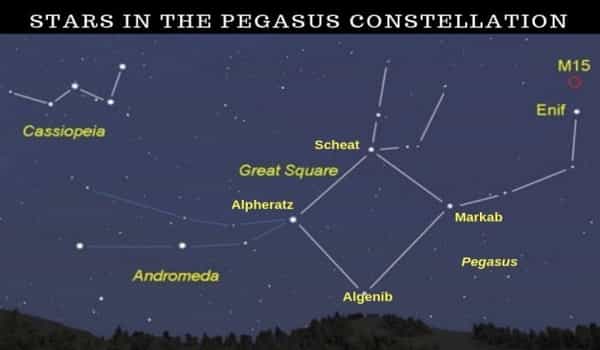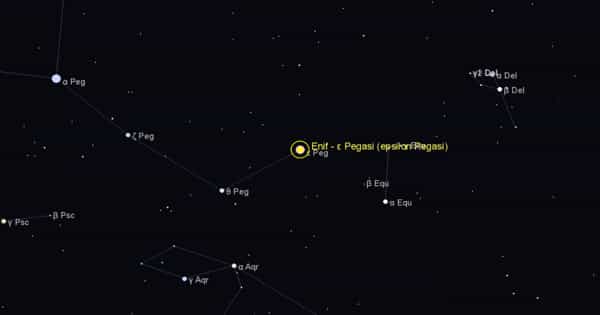Epsilon Pegasi, also known as Enif, is an orange supergiant star in the constellation Pegasus. It is the brightest star in Pegasus, the northern constellation. It represents the mythical winged horse’s muzzle. This is a second-magnitude star visible to the naked eye, with an apparent visual magnitude of 2.4. It is the brightest star in Pegasus, with an apparent magnitude of 2.399 on average. Using parallax measurements from the Hipparcos astrometry satellite, the distance to this star can be estimated to be around 690 light-years (210 parsecs). It is located approximately 690 light-years away from Earth.
Formation
Epsilon Pegasi arose approximately 20 million years ago from a rich interstellar medium of gas and dust. Gravity drew the swirling gas and dust together, giving birth to Pegasus’ brightest star, the supergiant Enif. The nearby yellow supergiants Sadalsuud / Beta Aquarii and Sadalmelik / Alpha Aquarii, the brightest stars in the Aquarius constellation, are thought to have formed from the same interstellar medium.
These three stars are roughly the same distance apart and move in the same direction through space, perpendicular to the Galactic plane. Sadalsuud is a G-type supergiant 540 light-years away, while Sadalmelik is a G-type supergiant 520 light-years away.
Location
Enif is easy to locate because it is close to the Great Square of Pegasus, a prominent asterism that outlines the main body of Pegasus. The star is located between Markab, the star in the southwest corner of the Great Square, and Delphinus, which is distinguished by its prominent kite-shaped pattern. Enif is the brightest star in this sky region.
Enif is approximately three degrees southeast of Messier 15, also known as the Great Pegasus Cluster. The globular cluster is one of the Milky Way’s brightest (magnitude 6.2), densest, and oldest clusters. It is 12 billion years old and 33,600 light-years away.

Properties
The stellar classification of the star as a K-type star indicates that it is a highly evolved orange giant with a diameter of about 185 times that of the Sun. Although the temperature of Epsilon Pegasi is much lower than that of the Sun, its enormous bulk means that all of its light is radiated from a much larger surface area, thus its luminosity of 12,250 sol.
Enif’s supply of hydrogen has been depleted in only about 20 million years due to its mass, and it is expected to die within the next few million years or so. However, because its mass lies on the dividing line between stars that explode as supernovae and those that do not, the mechanism of its demise is unknown.
Physical characteristics
The stellar classification of K2 Ib indicates that Epsilon Pegasi is a red supergiant star. It is estimated to be 12 times the mass of the Sun. After adjusting for limb darkening, the measured angular diameter of this star is 8.17 0.09 mas. At the estimated distance of this star, this results in a massive physical size that is approximately 185 times the radius of the Sun. It radiates approximately 12,250 times the luminosity of the Sun from this expanded envelope at an effective temperature of 4,337 K. Because it is cooler than the Sun, it has the orange-hued glow of a K-type star.
Epsilon Pegasi has been observed to brighten dramatically on a few occasions, giving rise to the theory that it (and possibly other supergiants) erupt in massive flares dwarfing those of the Sun. It is a slow irregular variable star of type LC with a magnitude range of +0.7 to +3.5. The spectrum shows an excess of the elements strontium and barium, which could be due to the s-process of nucleosynthesis in the star’s outer atmosphere. It has a relatively high peculiar velocity of 21.6 km s-1.
















